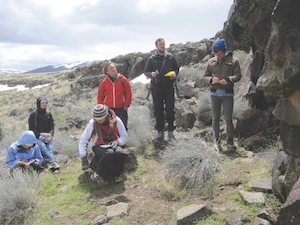 Can studying “abroad” can be just as enriching in your state’s backyard as it is when traveling to other countries?
Can studying “abroad” can be just as enriching in your state’s backyard as it is when traveling to other countries?
Oregon is a great place to ramble if you’re interested in geology. Volcanoes, craters, buttes and ancient floodplains are among the many geologic features that offer clues about life on Earth over the last 10,000 or even 10 million years.
But Oregon is equally fascinating if you care about the present tense. With its diversity of ecosystems—forests, deserts, mountains and seashores—the state provides a living laboratory for the biologically minded.
Last spring, a select group of students had an opportunity to explore all of the above through a unique set of courses that combined biology and geology—along with history—in a pilot called Oregon Abroad.
 The name plays off the concept of study abroad, but with a twist: what if going “abroad” can be just as enriching in your state’s backyard as it is when traveling to other countries? True to this spirit, the program sends students out into the field to explore Oregon’s dramatic landscapes and rich Native American history.
The name plays off the concept of study abroad, but with a twist: what if going “abroad” can be just as enriching in your state’s backyard as it is when traveling to other countries? True to this spirit, the program sends students out into the field to explore Oregon’s dramatic landscapes and rich Native American history.
Right: Oregon Abroad students visited Hart Mountain, among numerous other field sites, to explore the connections between geology, biology and history.
The initial cohort of twenty students spent at least one full day per week outside observing and analyzing the state’s natural phenomena. The course began in the Willamette Valley, moved to Oregon’s coast range and ended in the iconic volcanic landscapes east of the Cascades. During the last third of the term the class spent nine days at Malheur Field Station in the Great Basin.
Created and taught by a biologist, a geologist and a historian—Bitty Roy, Josh Roering and Matthew Dennis, respectively—the program aimed to deepen students’ understanding of each academic subject and also utilize the unique outdoor setting to discover, as a team, how these various subjects are inextricably linked.
“In a classroom, the tendency is to focus on a few abstract details, but outside, you’re constantly reminded of interconnections,” said Roy, a professor of biology. “You can really see the interaction between the landscapes and the plants, and the fact that they influence one another.”
For example, students kept records of landform types, soil pH and associated plant communities, a practice that emphasized the relationship between geologic formations and local flora.
Students also examined ancient petroglyphs, evaluated the impact of timber harvests on erosion, mapped meandering rivers, completed biologic transects of hills in the coast range and explored underground lava tubes.
“As historians, we don’t get out in the field so much,” said Dennis, a professor of history. “It was an unusual opportunity to take history students out and to use real places the way you would use a printed document.” And then there was the chance to explore how history is informed by physical and natural science. “We were able to use some of the scientific techniques from biology and geology to reconstruct what places might have looked like in the past,” Dennis reported. “And how they have changed over time.”
“It was great to get out of the classroom and have tangible experiences rooted to a physical place,” said Oregon Abroad student Leisha Wood, now a senior majoring in environmental studies.
Wood also emphasized her appreciation for the team approach fostered by the faculty mentors.
“As early as the second day, everyone was contributing to the discussion. That doesn’t ever happen in the classroom.”
Roy, Dennis and Roering, an associate professor of geological sciences, plan to offer the course again in 2013 and to continue the program every other year.
—Patricia Hickson






 study by UO economists, released just before the Rose Bowl, has been picked up by the media far and wide.
study by UO economists, released just before the Rose Bowl, has been picked up by the media far and wide.